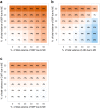Random measurement error: Why worry? An example of cardiovascular risk factors
- PMID: 29425217
- PMCID: PMC5806872
- DOI: 10.1371/journal.pone.0192298
Random measurement error: Why worry? An example of cardiovascular risk factors
Abstract
With the increased use of data not originally recorded for research, such as routine care data (or 'big data'), measurement error is bound to become an increasingly relevant problem in medical research. A common view among medical researchers on the influence of random measurement error (i.e. classical measurement error) is that its presence leads to some degree of systematic underestimation of studied exposure-outcome relations (i.e. attenuation of the effect estimate). For the common situation where the analysis involves at least one exposure and one confounder, we demonstrate that the direction of effect of random measurement error on the estimated exposure-outcome relations can be difficult to anticipate. Using three example studies on cardiovascular risk factors, we illustrate that random measurement error in the exposure and/or confounder can lead to underestimation as well as overestimation of exposure-outcome relations. We therefore advise medical researchers to refrain from making claims about the direction of effect of measurement error in their manuscripts, unless the appropriate inferential tools are used to study or alleviate the impact of measurement error from the analysis.
Conflict of interest statement
Figures

References
-
- Rothman KJ, Greenland S, Lash TL, editors. Modern Epidemiology. 3rd ed Philadelphia, PA, USA: Lippincott Williams & Wilkins; 2008.
-
- Obermeyer Z, Emanuel EJ. Predicting the Future—Big Data, Machine Learning, and Clinical Medicine. N Engl J Med. 2016;375: 1216–1219. doi: 10.1056/NEJMp1606181 - DOI - PMC - PubMed
-
- Dosemeci M, Wacholder S, Lubin JH. Does nondifferential misclassification of exposure always bias a true effect toward the null value? Am J Epidemiol. 1990;132: 373–375. - PubMed
-
- Jurek AM, Greenland S, Maldonado G, Church TR. Proper interpretation of non-differential misclassification effects: Expectations vs observations. Int J Epidemiol. 2005;34: 680–687. doi: 10.1093/ije/dyi060 - DOI - PubMed
-
- Jurek AM, Greenland S, Maldonado G. Brief Report: How far from non-differential does exposure or disease misclassification have to be to bias measures of association away from the null? Int J Epidemiol. 2008;37: 382–385. doi: 10.1093/ije/dym291 - DOI - PubMed
Publication types
MeSH terms
LinkOut - more resources
Full Text Sources
Other Literature Sources
Molecular Biology Databases

